Thu 5 Jan 2012
Mike Nevins on RAYMOND CHANDLER, HARRY STEPHEN KEELER, FRED DANNAY and ROBERT E. BRINEY.
Posted by Steve under Authors , Columns , Obituaries / Deaths Noted[22] Comments
by Francis M. Nevins
As a novice widower I find myself thinking of three other mystery writers who lost wives to Mister Death. The first name that springs to mind in this connection is Raymond Chandler (1888-1959), who was so devastated by the death of his wife Cissie that he tried to shoot himself in his bathroom.
Being blind drunk at the time, he missed his target. “She was the music heard faintly at the edge of sound…†he said of Cissie. “She was the light of my life, my whole ambition. Anything else I did was just the fire for her to warm her hands at.â€
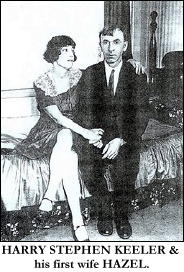
Next comes Harry Stephen Keeler (1890-1967), whom I never met but have been associated with for most of my life. He married the former Hazel Goodwin in 1919 and they were together until she died of cancer in May 1960.
During the months of her final illness and after her death he was unable to write fiction, but he continued sending out his off-the-wall “Walter Keyhole†newsletters to just about everyone whose address he had.
He called them polychromatic or multitinctorial cartularies since each page was printed on paper of a different color. We who have lived into the computer age recognize them as the functional equivalent of a blog. It cost him as much as $50 to have each installment prepared by a professional typing service and mailed out en masse.
I have originals or photocopies of 188 of these, which a few years ago I organized and offered to a panting public as The Keeler Keyhole Companion (2005). Among the hundreds of topics he touched on was his life as a lonely widower in his early seventies, “a guy who lives on canned Campbell’s soups and canned Sultana pork and beans.â€
Here’s his account of the “long lonely Thanksgiving holiday†in 1962. “We [he often uses the royal we in these cartularies] had our choice of having 3 soft-boiled eggs (only thing we can cook) as a dinner, then seeing the Three Stooges conk each other over the heads [at the local movie house], or of having 3 soft-boiled eggs as a dinner and re-reading Keyser’s Mathematical Philosophy. You guess!â€
I now feel closer to that genuine mad genius than ever before. He was only a year or two older at his wife’s death than I at Patty’s. He sold the old house they had lived in for decades and moved into an apartment hotel, while I’ve recently bought a condo and put my own Toad Hall on the market. I’m no better at cheffery than Harry was but have the advantage of living in the age of that fantastic contraption known as the microwave.
The third author in whose moccasins I now walk became a widower not once but twice. Fred Dannay (1905-1982), better known as Ellery Queen, married the former Mary Beck in 1926. She died of cancer on July 4, 1945, leaving Fred with two small children to raise.
In 1947 he married the former Hilda Wiesenthal, who was ten or eleven years younger than he and was the daughter of a cousin of Nazi hunter Simon Wiesenthal. She died in 1972, also of cancer.
By that time I had come to know Fred well and he had become the closest thing to a grandfather I had ever known. I went through this awful period of his life with him. There’s a photograph of him taken at this time which shows the empty devastated face of a man waiting for the dark to claim him.
Just as Keeler had married again a few years after Hazel’s death, so did Fred a few years after Hilda’s. I got to know Thelma Keeler well and am convinced that she saved her husband’s life. I also have no doubt that Fred’s third marriage, to the former Rose Koppel, saved his. Will I luck out in my final years as they did?
I apologize for devoting so much of this column to death but I really don’t have much choice at the moment. Less than a week before Christmas I learned that I’d lost one of my closest mystery-loving friends.
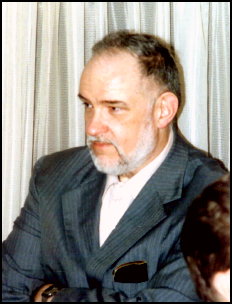
Bob Briney was something of a universal genius. Physically he evoked Orson Welles or Nero Wolfe but was soft-spoken and totally without their irascibility and moved with a certain gingerliness as if he were afraid he’d crush something if his movements were more forceful.
He was born near Benton Harbor, Michigan in December 1933 and spent most of his academic career in Massachusetts, at Salem State University. He earned a Ph.D. in mathematics and recovered from the ordeals of his dissertation and orals, so he told me, by reading most of the novels of John Dickson Carr in less than a month.
Like the clever men of Oxford in The Wind in the Willows, he “knew all that was to be knowed‗about mystery fiction, fantasy, s-f, horror, Westerns, just about every form of popular fiction you can name, plus ballet and opera and movies and classical music and so much more.
His ability to keep prodigious masses of data in perfectly organized form would have shamed many a computer. He wrote prolifically and with dry wit about books and authors, assiduously collected works in the genres he loved — every room in his large house including the bathroom was a library first and foremost — and corresponded with Sax Rohmer, P.G. Wodehouse, John Creasey and countless other authors.
It was pure pleasure to read his commentary or listen to his conversation. We started corresponding in the late Sixties, thanks mainly to Al Hubin and The Armchair Detective, and met for the first time in 1970 when I took a bus from New Jersey to a science fiction convention in Manhattan that he was attending.
Beginning in 1980 he followed in Keeler’s footsteps by putting out the pre-computer equivalent of a blog, which he called Contact Is Not a Verb (a famous line from one of Rex Stout’s Nero Wolfe novels) and kept going until September 2006, a grand total of 149 issues, of a copy of every one of which I am a proud possessor.
Bob developed diabetes and in the fall of 1990, when I was a visiting professor in New Jersey, had to have some of his toes amputated. Unable to climb the stairs of his own house, he was sleeping in a hospital bed installed on the ground floor. I traveled to Salem by Amtrak and spent a long weekend playing housekeeper: schlepping cartons around so he could access the classical music he loved, taking his clothes to the laundry, even cooking us a few meals (for whose quality I will not vouch).
Until a few years ago we would rendezvous every summer at the Pulpcon in Dayton, Ohio. Then unaccountably this shy but gregarious man dropped out of sight. Almost no one heard a word from him or knew anything about his health.
Finally, just a few days before Christmas, I learned he’d been found dead in his house late in November. He had no immediate family. As of this writing I don’t know the cause, or what will happen to the vast library he had accumulated over the decades. All I know is that he was one of the most brilliant and memorable people in my life.
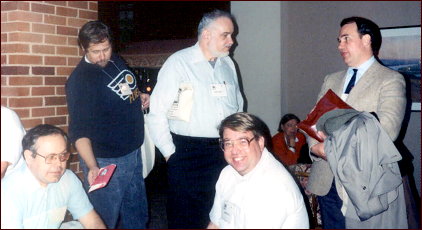
Bouchercon, Philadelphia, 1989. Me (Steve Lewis), Art Scott, Bob Briney, George Kelley, and Mike Nevins. Photo taken by Ellen Nehr.
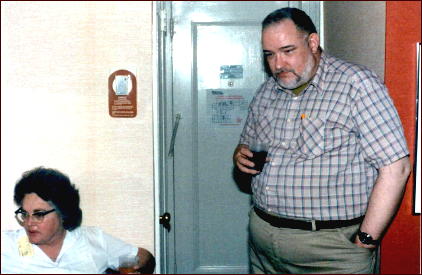
Bouchercon, New York, 1983. Ellen Nehr and Bob Briney.
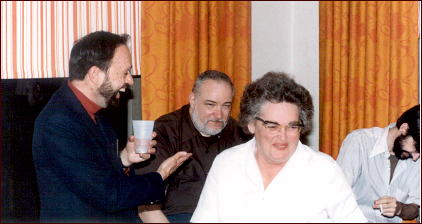
Bouchercon, Chicago, 1984. Marv Lachman, Bob Briney, Ellen Nehr and Steve Stilwell.
Many thanks to Art Scott for providing the photos above.
January 5th, 2012 at 12:26 pm
Mike, I hope you get through this difficult period. I’m sorry to hear about Bob Briney. I used to see him at Pulpcon but then he stopped attending. I remember his work in TAD and somewhere I have the issues of THE ROHMER REVIEW that he edited.
January 5th, 2012 at 12:57 pm
I’m sorry for your losses, Mike. Bob was a unique individual and a valued member of DAPA-Em, from which he disappeared without a word. He was missed by many then, and he’ll be missed by many more now. I’m truly sorry he’s gone.
January 5th, 2012 at 1:22 pm
Mike,
You say that you first met Bob in 1970 at a science fiction convention in downtown Manhattan. I’ll bet that that’s the same place I first met him. Judy and I moved to CT in 1969, and I took the train down to New York City the next spring (?) to (I think) Lunacon 1970. I don’t know how he recognized me from my name tag, perhaps from letters in TAD, but he did.
He was a man of contradictions in many ways, and the phrase “shy but gregarious” fit him perfectly. He was also bulky in size but until the operation on his foot, he moved with considerable grace.
I hope he realized how many people missed him after he dropped out of sight. I’ll echo Bill here and say that he’ll be missed by many more now, including me.
January 5th, 2012 at 4:10 pm
Mike,
A fine and moving study. I still remember a wonderful day book-hunting with Bob and Ellen.
January 5th, 2012 at 5:14 pm
Mike, I was moved by your comments on all your subjects, but Bob Briney was the only one I knew personally. You touched on all the qualities I admired in him and reminded me how much we’ve all lost in his passing.
January 5th, 2012 at 8:22 pm
Sorry to hear about your loss, Mike. I’ll never forget the time Ellen Nehr, Bob Briney, and I went to visit the Erle Stanley Gardner Library at the University of Texas-Austin. Ellen was enthusiastic (as she was about most three-named writers) and Bob supplied a running commentary about ESG, his life and works. You could not imagine a more convivial set of companions!
January 6th, 2012 at 12:26 pm
Mike–
I was sorry to learn of Bob’s passing. I never met him but always enjoyed his “Contact Is Not a Verb” in DAPA. And once again, my condolences on the passing of your wife. Let’s all hope that 2012 is a better year.
Best,
Ted
January 6th, 2012 at 2:49 pm
I, too, knew Bob Briney personally, but not that intimately. I was always rewarded with a great big “Thank You” from Bob for any Fu Manchu or Sax Rohmer material I plugged in to the sorely missed Sax Rohmer web site. I knew from my friend, Ken Johnson, who used to periodically visit Bob that, healthwise, Bob was not up to snuff. He sure will be missed.
Victor
January 6th, 2012 at 10:30 pm
Back in the 1970s I stayed with Bob Briney at the time of the Boston Bouchercon — this was in exchange for driving him to the convention each day. I used to look forward to seeing him at either the Bouchercon or at Pulpcon. I contributed the entry on Sax Rohmer to the Oxford Companion to Crime and Mystery Writing and used my set of The Rohmer Review as some of my source material. Obviously he will be sorely missed.
I knew Fred Dannay as well and had dinner with him and his wife Rose in 1980 when I was in upstate New York. There are so many questions I failed to ask him in our conversations.
January 9th, 2012 at 12:42 pm
I just hope Bob’s massive and marvelous book collection doesn’t end up in a landfill.
January 10th, 2012 at 1:28 pm
Bob Briney was a friend (and fellow member of DAPA-EM where his Contact is Not a Verb was highly prized)who I looked forward to seeing at Bouchercons and exchanging letters in those pre-email days. Somewhere I have a picture of him and Hal Rice sitting at a bar enjoying a conversation. Hal is another old friend I miss. Such a sad end. I do hope with George that his library was not carted out with the trash.
Dannay I met at the 50th anniversay celebration of Ellery Queen at the Lotus Club in New York City. What a gentleman of the old school. He was very kind to this star-struck fan.
January 11th, 2012 at 8:25 am
Although I recently retired from Salem State College (now Salem State University) it was an honor to have worked with Bob Briney as a member of the Computer Science Department for many years. Bob was a brilliant man and he provided endless help and support to his colleagues. Bob was a lifesaver when working on Curriculum Committe or department issues and Accreditation Reviews. His help and kindness extended throughout the university. He was a highly valued colleague and is dearly missed throughout the Salem State Community. His long and valued career is being celebrated next week with a special tribute by the University and a huge turnout is expected for this kind and gentle man who was a genius in many areas. Please rest assured that Salem State University grieves the loss of our ‘Gentle Giant’ and highly valued colleague. Fond memories of him will remain with us for all time.
January 13th, 2012 at 2:46 pm
Dr. Campbell
Thanks for stopping by. It was good to learn more about the academic side of Bob that most of us knew little about. Nonetheless I wasn’t at all surprised to hear how many committees he was on and how well regarded he was. What had some of us concerned was that for the longest time we found nothing online about his passing, including the Salem newspaper or anything from the University.
He was indeed a “Gentle Giant.” It’s great news that the University will be paying a special tribute to him. Thanks again for letting us know.
— Steve
January 15th, 2012 at 9:31 pm
Thank you very much for your return comments about Bob Briney. I’d like to add another word or two about Bob. As you know Bob was a highly respected colleague and he was a ‘walking encyclopedia’ of so many areas of the Compter Science Department and University Governance that his shoes can never be properly filled. Bob was a man of sharp contrasts. You will likely be surprised to learn that few people indeed knew of his ‘other life’ as a mystery writer.
Bob was a quiet genius who never boasted about his achievements. I worked with Bob for about 20 years at the University (6 of them as a colleague within the Computer Science Department) and I never knew of his high success in the field of mystery writing. I suspect few others were aware either. As of this writing I’ve learned that Bob died quietly at home. Although I recently retired to Florida I’m still an active member of the Computer Science Department because I teach Online Courses from my home. Since I don’t live up in Massachusetts anymore I don’t have access to the local papers but I can’t conceive of his passing not being noted in at least a local paper. If I can find more information on that I will surely pass it on to you.
As you can imagine, Bob’s loss was shock to all of us at the University. One of our faculty members was doing some research on Bob passing when he came across your blog where comments about his loss could be posted — I learned of the site and immediately made my post. Although I won’t be able to attend the University’s special Memorial to Bob Briney (I’m presently in Germany) it has been suggested (and I hope it will be implemented) that the warm and caring comments about Bob that are posted on your blog will be read to the gathering at the University’s Memorial service.
I hope that some of this new information will help others deal with the loss of our good friend.
Thank you again for your return comments.
Bob Campbell
January 15th, 2012 at 9:35 pm
I think that everyone who’s left a comment here would like to attend the memorial service for Bob, as well as anyone else who may have known him as only a fellow fan of mysteries and science fiction. But if we can’t be there in person, we’ll be there in spirit.
— Steve
January 18th, 2012 at 4:02 pm
Dear Friends in Fandom Â
Thank you for your kind comments about Bob Briney. I especially appreciate my friend, Bob Campbell, clarifying the significant role that Salem State University has taken in dealing with the complicated and sensitive legal issues that have arisen in the wake of the discovery that Bob was deceased. I have been a professor of psychology here for 33 years and live close to Bob’s house in South Salem. I served with Bob on several university governance committees and shared his love of science fiction.
Salem State has stepped in and acted as his family, without any requirement or directive to do so. This action is all the more noteworthy because the university president who chose to take on these responsibilities did not know Bob personally. She was motivated to do “the right thing†by him and directed her administration to do everything possible to settle his affairs and honor him.
An extensive tribute to Bob was circulated on campus, but a notice will not be published in the local newspapers, apparently for legal reasons.
I will send the notice of the memorial service for Bob to Steve, so he can post it as he sees fit. Thanks again.
Pat Markunas
January 19th, 2012 at 10:24 am
Pat
I’ve added the official notice of the memorial service to this later post in which Bob Campbell first told me about it.
https://mysteryfile.com/blog/?p=14544
Thank you for describing in detail what the Bob Briney’s friends and colleagues at Salem State have been doing to help settle his affairs and to honor him in this fashion. Everything that’s been done is extremely gratifying to those of us who’ve known him from the fannish non-academic side of his life.
— Steve
PS. Thanks also for the reassurance in a separate email that Bob’s library of books and magazines will not be disposed of in an unknowing manner. The collection he put together was a great part of his life, and none of us in the fannish community wanted to see it arbitrarily broken up.
January 21st, 2012 at 8:58 pm
SALEM NEWS OBITUARY FOR BOB BRINEY. Entire obituary with photos is available at the link below:
http://www.salemnews.com/obituaries/x1669697280/Dr-Robert-E-Briney-Jr-77
Dr. Robert E. Briney, Jr., 77
SALEM — Dr. Robert “Bob” E. Briney, Jr., 77, of Salem, a professor in the Mathematics Department and Computer Science Department of Salem State University from 1968-2008, died unexpectedly at his home on November 25, 2011.
Born in Benton Harbor, MI, Bob was the son of the late Robert E. Briney Sr. and Catherine (Duncan) Briney. He was raised and educated in Benton Harbor and Muskegon, MI and graduated high school in 1951. He matriculated to Northwestern University in Evanston, IL where he earned an A.B. in Mathematics with a minor in Philosophy and Modern Languages. Bob relocated to Cambridge, MA and attended the Massachusetts Institute of Technology during the mid-1950s. In 1961 he earned a Ph.D. in Mathematics with a minor in Languages from M.I.T.
An educator by profession, Bob taught at M.I.T. and Purdue University prior to joining the faculty of Salem State College in 1968 as a professor of mathematics. Bob served two terms as Chair of the Mathematics Department. In 1977 Bob founded Salem State’s Computer Science Department and served four terms as its Chair.
Bob’s contributions to the development of the Computer Science major were essential to its approval in 1984 and formed the core of the curriculum that received ABET accreditation in 2003. Bob was a published academic with memberships in several departmental governance committees. He was a longtime dedicated member and secretary of the College Curriculum Committee and he received the Distinguished Service Award three times during his tenure with Salem State.
Bob’s avocations, however, were in the fields of mystery writing, science fiction and fantasy. A freelance writer and editor, he contributed to numerous publications including Classical Outlook, The Armchair Detective and the Journal of Popular Culture. In 1970 he took over as editor/publisher of The Rohmer Review and contributed to many other journals and publications over the course of his life. He was a member of the Mystery Writers of America and the Science Fiction Research Association.
He was a leading expert on author Sax Rohmer and lectured on aspects of crime and mystery fiction at various universities. Bob wrote prolifically and with dry wit about the books and authors of the genres he loved; his appetite for mystery, science fiction and fantasy novels was insatiable. He assiduously collected a vast library as well as a capacious music collection including styles ranging from jazz to classical to medieval troubadour.
Bob was a man of many interests and hobbies who shared his passions with others. He enjoyed friendships with fellow mystery aficionados from across the U.S. and Canada. Bob was a devoted professor and mentor who helped inspire countless students throughout his career. He will be deeply missed by many friends, colleagues and former students. His legacy will always be held in high esteem for the lasting impact that he made at Salem State University, his contributions to the world of mystery/fiction literature and the inspiration that he provided to numerous scholars.
Bob is survived by his sister, Marie Butcher of Michigan, his nephew, Donald Butcher of Hawaii, as well as many colleagues and dear friends.
ARRANGEMENTS: His funeral service will be held Monday, January 23, 2012, graveside in the Greenlawn Cemetery, Salem at 9 A.M. Relatives and friends invited. A memorial service will be held on Tuesday, February 7, 2012 at 12:30 p.m. in the Martin Luther King Room of the Ellison Campus Center located on Salem State University’s North Campus. Contact: Patricia Kantorosinski, Computer Science Department (978-542-6256). Assisting with the funeral arrangements is The O’Donnell Funeral Home, 46 Washington Sq. (at Salem Common), Salem. To share a memory or offer a condolence, please visit http://www.odonnellfuneralservice.com or for further information, inquire at 978-744-2350.
January 24th, 2012 at 5:47 am
Mike, I’m so sorry to hear of your loss. You’ll be in my thoughts and prayers.
Also very sorry to hear about Bob. He’ll be missed.
January 24th, 2012 at 8:38 am
Dear Literary Friends of Professor Briney:
I presided at his burial service yesterday at Greenlawn Cemetery in Salem, MA. It was well attended by friends and colleagues from Salem State U. He was remembered with fondness and great respect. Some of the fond memories offered by Mr. Nevins were used at his service.
April 12th, 2012 at 10:35 am
I met Bob in person through Ellen Nehr, although I first became aware of him through DAPA-EM. I didn’t know him well, but we usually spoke together at some of the 80’s Bouchercons and I was able to give him a rare document which he’d only heard of but never seen. It was a shock to come across this posting and to realize that he only recently died. For some reason, I had assumed that he passed around the time Ellen did. Both loved and respected the genre so much that it made me glad to be a part of it.
August 22nd, 2012 at 4:34 pm
Odd happenstance that I now have a correlation to Bob, with whom I have no aquaintence. At the ripe age of 44, I have been been seeking out some of the totems of youth. Giddily paging through old scifi magazines, Starlog 1978, Omni, but most interesting a copy of Locus – 1989 The Year in Science Fiction… a copy with Bob’s mailing label. That will now have additional meaning and have safe harbor.
My Respects,
Bryan Pike